SUZUKI XL7 2007 2.G Owners Manual
Manufacturer: SUZUKI, Model Year: 2007, Model line: XL7, Model: SUZUKI XL7 2007 2.GPages: 274, PDF Size: 6.12 MB
Page 181 of 274
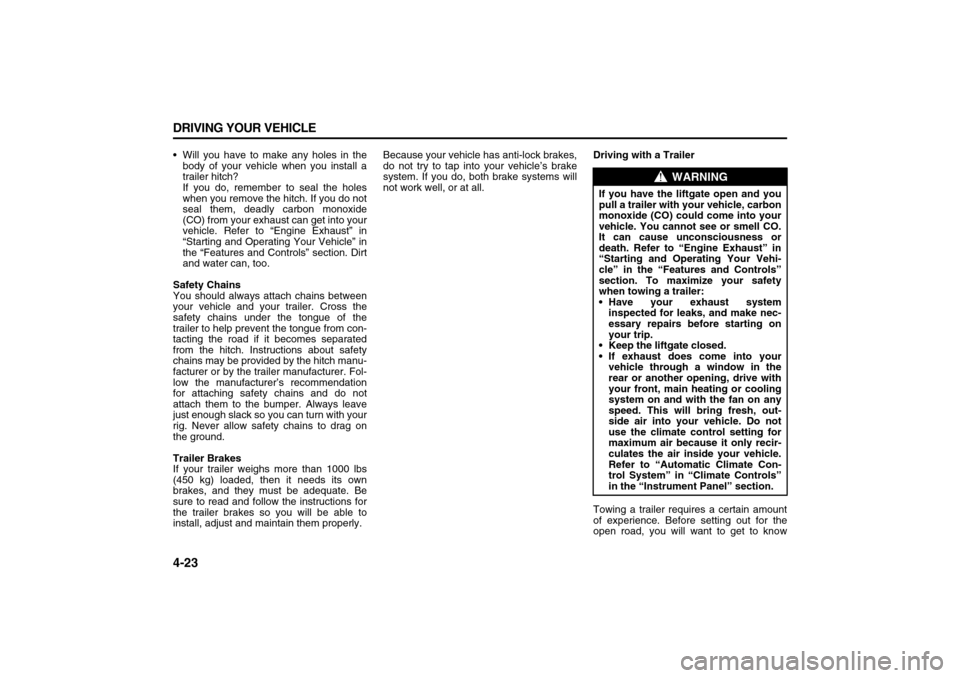
4-23 DRIVING YOUR VEHICLE
78J00-03E
Will you have to make any holes in the
body of your vehicle when you install a
trailer hitch?
If you do, remember to seal the holes
when you remove the hitch. If you do not
seal them, deadly carbon monoxide
(CO) from your exhaust can get into your
vehicle. Refer to “Engine Exhaust” in
“Starting and Operating Your Vehicle” in
the “Features and Controls” section. Dirt
and water can, too.
Safety Chains
You should always attach chains between
your vehicle and your trailer. Cross the
safety chains under the tongue of the
trailer to help prevent the tongue from con-
tacting the road if it becomes separated
from the hitch. Instructions about safety
chains may be provided by the hitch manu-
facturer or by the trailer manufacturer. Fol-
low the manufacturer’s recommendation
for attaching safety chains and do not
attach them to the bumper. Always leave
just enough slack so you can turn with your
rig. Never allow safety chains to drag on
the ground.
Trailer Brakes
If your trailer weighs more than 1000 lbs
(450 kg) loaded, then it needs its own
brakes, and they must be adequate. Be
sure to read and follow the instructions for
the trailer brakes so you will be able to
install, adjust and maintain them properly.Because your vehicle has anti-lock brakes,
do not try to tap into your vehicle’s brake
system. If you do, both brake systems will
not work well, or at all.Driving with a Trailer
Towing a trailer requires a certain amount
of experience. Before setting out for the
open road, you will want to get to know
WARNING
If you have the liftgate open and you
pull a trailer with your vehicle, carbon
monoxide (CO) could come into your
vehicle. You cannot see or smell CO.
It can cause unconsciousness or
death. Refer to “Engine Exhaust” in
“Starting and Operating Your Vehi-
cle” in the “Features and Controls”
section. To maximize your safety
when towing a trailer:
Have your exhaust system
inspected for leaks, and make nec-
essary repairs before starting on
your trip.
Keep the liftgate closed.
If exhaust does come into your
vehicle through a window in the
rear or another opening, drive with
your front, main heating or cooling
system on and with the fan on any
speed. This will bring fresh, out-
side air into your vehicle. Do not
use the climate control setting for
maximum air because it only recir-
culates the air inside your vehicle.
Refer to “Automatic Climate Con-
trol System” in “Climate Controls”
in the “Instrument Panel” section.
Page 182 of 274
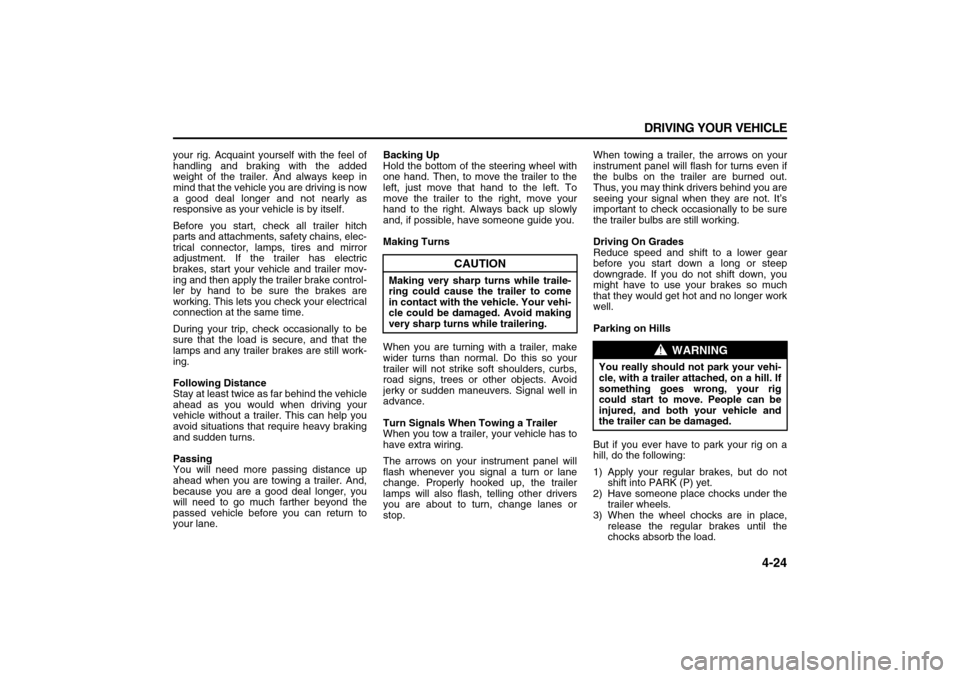
4-24 DRIVING YOUR VEHICLE
78J00-03E
your rig. Acquaint yourself with the feel of
handling and braking with the added
weight of the trailer. And always keep in
mind that the vehicle you are driving is now
a good deal longer and not nearly as
responsive as your vehicle is by itself.
Before you start, check all trailer hitch
parts and attachments, safety chains, elec-
trical connector, lamps, tires and mirror
adjustment. If the trailer has electric
brakes, start your vehicle and trailer mov-
ing and then apply the trailer brake control-
ler by hand to be sure the brakes are
working. This lets you check your electrical
connection at the same time.
During your trip, check occasionally to be
sure that the load is secure, and that the
lamps and any trailer brakes are still work-
ing.
Following Distance
Stay at least twice as far behind the vehicle
ahead as you would when driving your
vehicle without a trailer. This can help you
avoid situations that require heavy braking
and sudden turns.
Passing
You will need more passing distance up
ahead when you are towing a trailer. And,
because you are a good deal longer, you
will need to go much farther beyond the
passed vehicle before you can return to
your lane.Backing Up
Hold the bottom of the steering wheel with
one hand. Then, to move the trailer to the
left, just move that hand to the left. To
move the trailer to the right, move your
hand to the right. Always back up slowly
and, if possible, have someone guide you.
Making Turns
When you are turning with a trailer, make
wider turns than normal. Do this so your
trailer will not strike soft shoulders, curbs,
road signs, trees or other objects. Avoid
jerky or sudden maneuvers. Signal well in
advance.
Turn Signals When Towing a Trailer
When you tow a trailer, your vehicle has to
have extra wiring.
The arrows on your instrument panel will
flash whenever you signal a turn or lane
change. Properly hooked up, the trailer
lamps will also flash, telling other drivers
you are about to turn, change lanes or
stop.When towing a trailer, the arrows on your
instrument panel will flash for turns even if
the bulbs on the trailer are burned out.
Thus, you may think drivers behind you are
seeing your signal when they are not. It’s
important to check occasionally to be sure
the trailer bulbs are still working.
Driving On Grades
Reduce speed and shift to a lower gear
before you start down a long or steep
downgrade. If you do not shift down, you
might have to use your brakes so much
that they would get hot and no longer work
well.
Parking on Hills
But if you ever have to park your rig on a
hill, do the following:
1) Apply your regular brakes, but do not
shift into PARK (P) yet.
2) Have someone place chocks under the
trailer wheels.
3) When the wheel chocks are in place,
release the regular brakes until the
chocks absorb the load.
CAUTION
Making very sharp turns while traile-
ring could cause the trailer to come
in contact with the vehicle. Your vehi-
cle could be damaged. Avoid making
very sharp turns while trailering.
WARNING
You really should not park your vehi-
cle, with a trailer attached, on a hill. If
something goes wrong, your rig
could start to move. People can be
injured, and both your vehicle and
the trailer can be damaged.
Page 183 of 274

4-25 DRIVING YOUR VEHICLE
78J00-03E
4) Reapply the regular brakes. Then apply
your parking brake, and then shift to
PARK (P).
5) Release the regular brakes.
When You Are Ready to Leave After
Parking on a Hill
1) Apply your regular brakes and hold the
pedal down while you do the following:
1. Start your engine.
2. Shift into a gear.
3. Release the parking brake.
2) Let up on the brake pedal.
3) Drive slowly until the trailer is clear of
the chocks.
4) Stop and have someone pick up and
store the chocks.
Maintenance When Trailer Towing
Your vehicle will need service more often
when you are pulling a trailer. See the
Maintenance Schedule for more on this.
Things that are especially important in
trailer operation are automatic transaxle
fluid, engine oil, belts, cooling system and
brake system. Each of these is covered in
this manual, and the Index will help you
find them quickly. If you are trailering, it is a
good idea to review these sections before
you start your trip.
Check periodically to see that all hitch nuts
and bolts are tight.
Page 184 of 274
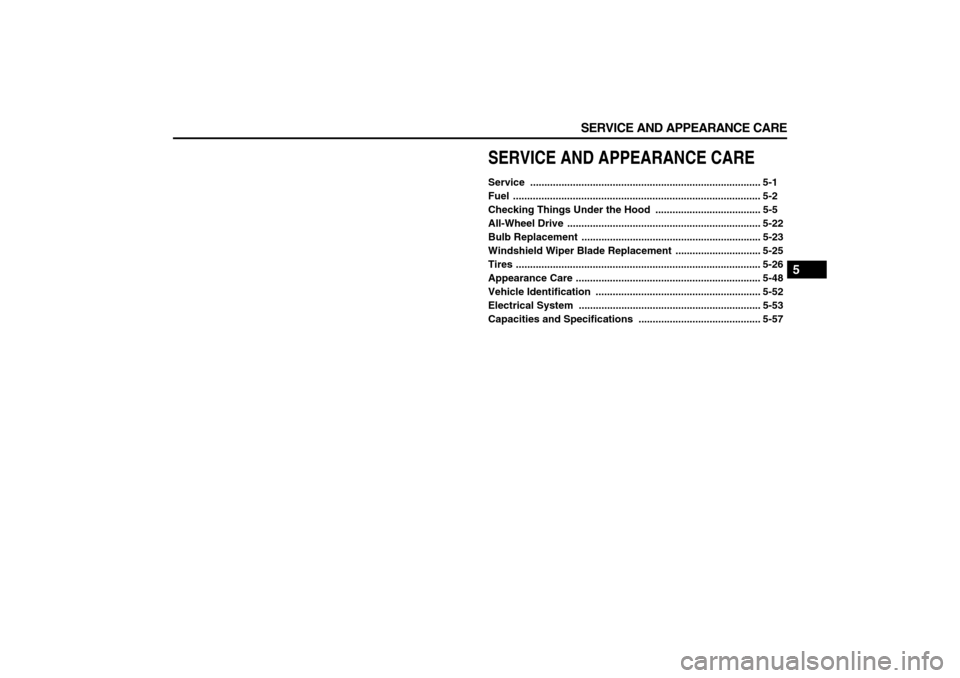
SERVICE AND APPEARANCE CARE
5
78J00-03E
SERVICE AND APPEARANCE CAREService ................................................................................. 5-1
Fuel ....................................................................................... 5-2
Checking Things Under the Hood ..................................... 5-5
All-Wheel Drive .................................................................... 5-22
Bulb Replacement ............................................................... 5-23
Windshield Wiper Blade Replacement .............................. 5-25
Tires ...................................................................................... 5-26
Appearance Care ................................................................. 5-48
Vehicle Identification .......................................................... 5-52
Electrical System ................................................................ 5-53
Capacities and Specifications ........................................... 5-57
Page 185 of 274
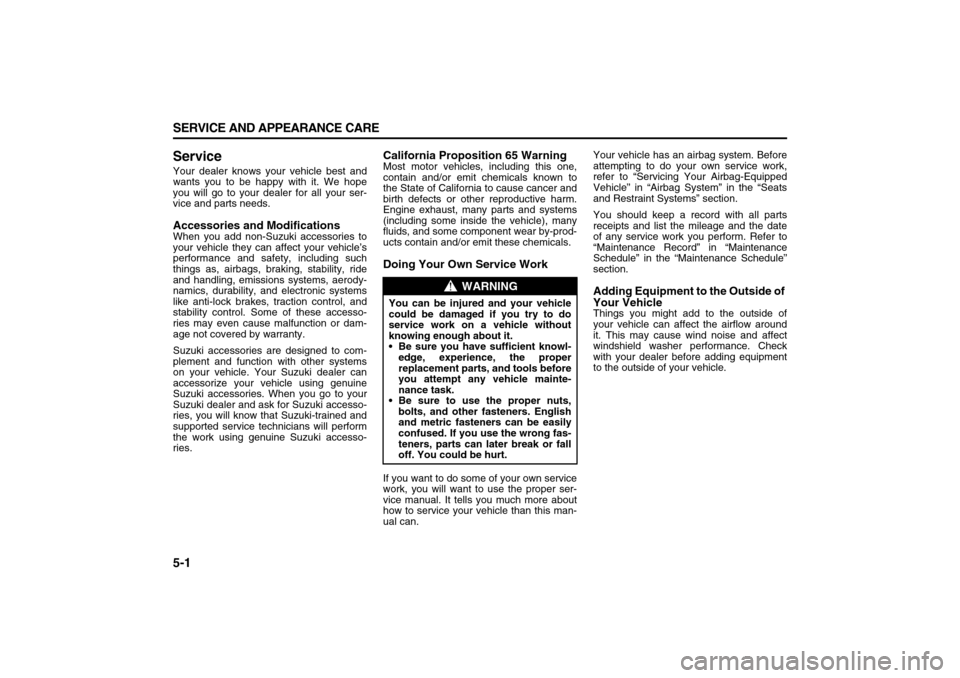
5-1 SERVICE AND APPEARANCE CARE
78J00-03E
ServiceYour dealer knows your vehicle best and
wants you to be happy with it. We hope
you will go to your dealer for all your ser-
vice and parts needs.Accessories and ModificationsWhen you add non-Suzuki accessories to
your vehicle they can affect your vehicle’s
performance and safety, including such
things as, airbags, braking, stability, ride
and handling, emissions systems, aerody-
namics, durability, and electronic systems
like anti-lock brakes, traction control, and
stability control. Some of these accesso-
ries may even cause malfunction or dam-
age not covered by warranty.
Suzuki accessories are designed to com-
plement and function with other systems
on your vehicle. Your Suzuki dealer can
accessorize your vehicle using genuine
Suzuki accessories. When you go to your
Suzuki dealer and ask for Suzuki accesso-
ries, you will know that Suzuki-trained and
supported service technicians will perform
the work using genuine Suzuki accesso-
ries.
California Proposition 65 WarningMost motor vehicles, including this one,
contain and/or emit chemicals known to
the State of California to cause cancer and
birth defects or other reproductive harm.
Engine exhaust, many parts and systems
(including some inside the vehicle), many
fluids, and some component wear by-prod-
ucts contain and/or emit these chemicals.Doing Your Own Service WorkIf you want to do some of your own service
work, you will want to use the proper ser-
vice manual. It tells you much more about
how to service your vehicle than this man-
ual can.Your vehicle has an airbag system. Before
attempting to do your own service work,
refer to “Servicing Your Airbag-Equipped
Vehicle” in “Airbag System” in the “Seats
and Restraint Systems” section.
You should keep a record with all parts
receipts and list the mileage and the date
of any service work you perform. Refer to
“Maintenance Record” in “Maintenance
Schedule” in the “Maintenance Schedule”
section.
Adding Equipment to the Outside of
Your VehicleThings you might add to the outside of
your vehicle can affect the airflow around
it. This may cause wind noise and affect
windshield washer performance. Check
with your dealer before adding equipment
to the outside of your vehicle.
WARNING
You can be injured and your vehicle
could be damaged if you try to do
service work on a vehicle without
knowing enough about it.
Be sure you have sufficient knowl-
edge, experience, the proper
replacement parts, and tools before
you attempt any vehicle mainte-
nance task.
Be sure to use the proper nuts,
bolts, and other fasteners. English
and metric fasteners can be easily
confused. If you use the wrong fas-
teners, parts can later break or fall
off. You could be hurt.
Page 186 of 274

5-2 SERVICE AND APPEARANCE CARE
78J00-03E
FuelUse of the recommended fuel is an impor-
tant part of the proper maintenance of your
vehicle. To help keep the engine clean and
maintain optimum vehicle performance, we
recommend the use of gasoline advertised
as TOP TIER Detergent Gasoline.Gasoline OctaneUse regular unleaded gasoline with a
posted octane rating of 87 or higher. If the
octane rating is less than 87, you may
notice an audible knocking noise when you
drive, commonly referred to as spark
knock. If this occurs, use a gasoline rated
at 87 octane or higher as soon as possible.
If you are using gasoline rated at 87
octane or higher and you hear heavy
knocking, your engine needs service.
Gasoline SpecificationsAt a minimum, gasoline should meet
ASTM specification D 4814 in the United
States or CAN/CGSB-3.5 in Canada.
Some gasolines contain an octane-
enhancing additive called methylcyclopen-
tadienyl manganese tricarbonyl (MMT).
We recommend against the use of gaso-
lines containing MMT. Refer to “Additives”
in this section for additional information.California FuelIf your vehicle is certified to meet California
Emissions Standards, it is designed to
operate on fuels that meet California spec-
ifications. See the underhood emission
control label. If this fuel is not available in
states adopting California emissions stan-
dards, your vehicle will operate satisfacto-
rily on fuels meeting federal specifications,
but emission control system performance
may be affected. The malfunction indicator
lamp may turn on and your vehicle may fail
a smog-check test. Refer to “Malfunction
Indicator Lamp” in “Warning Lights, Gages,
and Indicators” in the “Instrument Panel”
section. If this occurs, return to your autho-
rized dealer for diagnosis. If it is deter-
mined that the condition is caused by the
type of fuel used, repairs may not be cov-
ered by your warranty.
AdditivesTo provide cleaner air, all gasolines in the
United States are now required to contain
additives that will help prevent engine and
fuel system deposits from forming, allow-
ing your emission control system to work
properly. In most cases, you should not
have to add anything to your fuel. How-
ever, some gasolines contain only the min-
imum amount of additive required to meet
U.S. Environmental Protection Agency
regulations. To help keep fuel injectors and
intake valves clean, or if your vehicle expe-
riences problems due to dirty injectors or
valves, look for gasoline that is advertised
as TOP TIER Detergent Gasoline. Also,
your dealer has additives that will help cor-
rect and prevent most deposit-related
problems.
Gasolines containing oxygenates, such as
ethers and ethanol, and reformulated gas-
olines may be available in your area. We
recommend that you use these gasolines,
if they comply with the specifications
described earlier. However, E85 (85% eth-
anol) and other fuels containing more than
10% ethanol must not be used in vehicles
that were not designed for those fuels.
Page 187 of 274
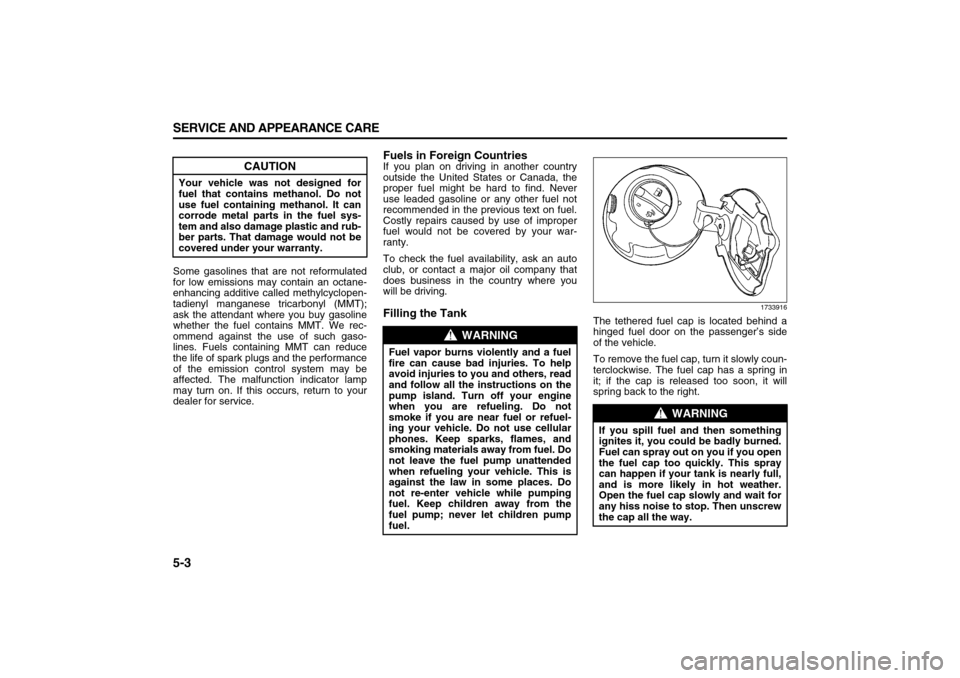
5-3 SERVICE AND APPEARANCE CARE
78J00-03E
Some gasolines that are not reformulated
for low emissions may contain an octane-
enhancing additive called methylcyclopen-
tadienyl manganese tricarbonyl (MMT);
ask the attendant where you buy gasoline
whether the fuel contains MMT. We rec-
ommend against the use of such gaso-
lines. Fuels containing MMT can reduce
the life of spark plugs and the performance
of the emission control system may be
affected. The malfunction indicator lamp
may turn on. If this occurs, return to your
dealer for service.
Fuels in Foreign CountriesIf you plan on driving in another country
outside the United States or Canada, the
proper fuel might be hard to find. Never
use leaded gasoline or any other fuel not
recommended in the previous text on fuel.
Costly repairs caused by use of improper
fuel would not be covered by your war-
ranty.
To check the fuel availability, ask an auto
club, or contact a major oil company that
does business in the country where you
will be driving.Filling the Tank
1733916
The tethered fuel cap is located behind a
hinged fuel door on the passenger’s side
of the vehicle.
To remove the fuel cap, turn it slowly coun-
terclockwise. The fuel cap has a spring in
it; if the cap is released too soon, it will
spring back to the right.
CAUTION
Your vehicle was not designed for
fuel that contains methanol. Do not
use fuel containing methanol. It can
corrode metal parts in the fuel sys-
tem and also damage plastic and rub-
ber parts. That damage would not be
covered under your warranty.
WARNING
Fuel vapor burns violently and a fuel
fire can cause bad injuries. To help
avoid injuries to you and others, read
and follow all the instructions on the
pump island. Turn off your engine
when you are refueling. Do not
smoke if you are near fuel or refuel-
ing your vehicle. Do not use cellular
phones. Keep sparks, flames, and
smoking materials away from fuel. Do
not leave the fuel pump unattended
when refueling your vehicle. This is
against the law in some places. Do
not re-enter vehicle while pumping
fuel. Keep children away from the
fuel pump; never let children pump
fuel.
WARNING
If you spill fuel and then something
ignites it, you could be badly burned.
Fuel can spray out on you if you open
the fuel cap too quickly. This spray
can happen if your tank is nearly full,
and is more likely in hot weather.
Open the fuel cap slowly and wait for
any hiss noise to stop. Then unscrew
the cap all the way.
Page 188 of 274
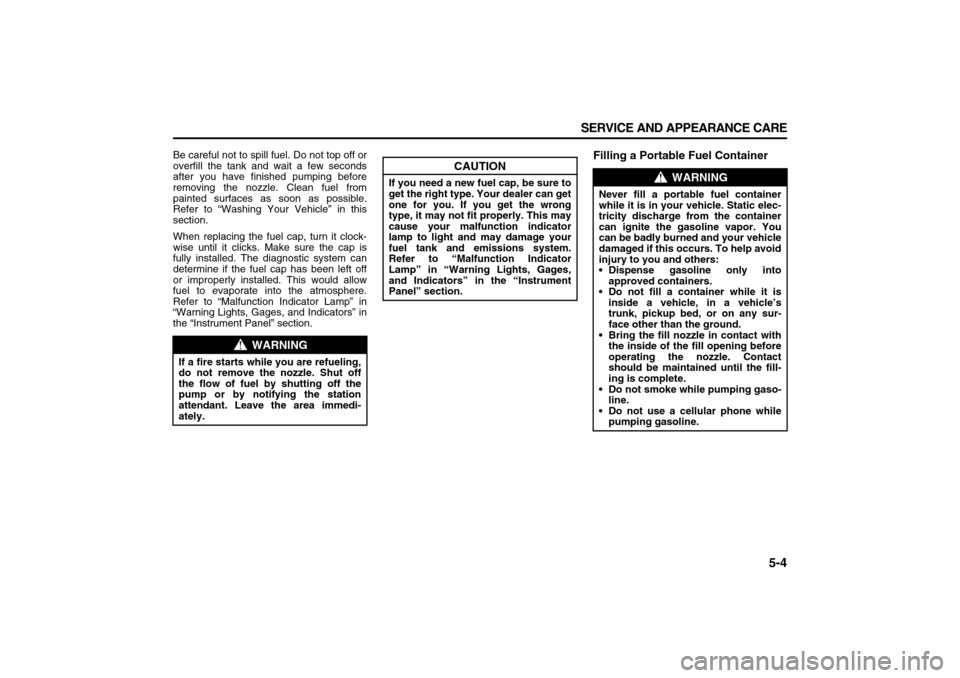
5-4 SERVICE AND APPEARANCE CARE
78J00-03E
Be careful not to spill fuel. Do not top off or
overfill the tank and wait a few seconds
after you have finished pumping before
removing the nozzle. Clean fuel from
painted surfaces as soon as possible.
Refer to “Washing Your Vehicle” in this
section.
When replacing the fuel cap, turn it clock-
wise until it clicks. Make sure the cap is
fully installed. The diagnostic system can
determine if the fuel cap has been left off
or improperly installed. This would allow
fuel to evaporate into the atmosphere.
Refer to “Malfunction Indicator Lamp” in
“Warning Lights, Gages, and Indicators” in
the “Instrument Panel” section.
Filling a Portable Fuel Container
WARNING
If a fire starts while you are refueling,
do not remove the nozzle. Shut off
the flow of fuel by shutting off the
pump or by notifying the station
attendant. Leave the area immedi-
ately.
CAUTION
If you need a new fuel cap, be sure to
get the right type. Your dealer can get
one for you. If you get the wrong
type, it may not fit properly. This may
cause your malfunction indicator
lamp to light and may damage your
fuel tank and emissions system.
Refer to “Malfunction Indicator
Lamp” in “Warning Lights, Gages,
and Indicators” in the “Instrument
Panel” section.
WARNING
Never fill a portable fuel container
while it is in your vehicle. Static elec-
tricity discharge from the container
can ignite the gasoline vapor. You
can be badly burned and your vehicle
damaged if this occurs. To help avoid
injury to you and others:
Dispense gasoline only into
approved containers.
Do not fill a container while it is
inside a vehicle, in a vehicle’s
trunk, pickup bed, or on any sur-
face other than the ground.
Bring the fill nozzle in contact with
the inside of the fill opening before
operating the nozzle. Contact
should be maintained until the fill-
ing is complete.
Do not smoke while pumping gaso-
line.
Do not use a cellular phone while
pumping gasoline.
Page 189 of 274
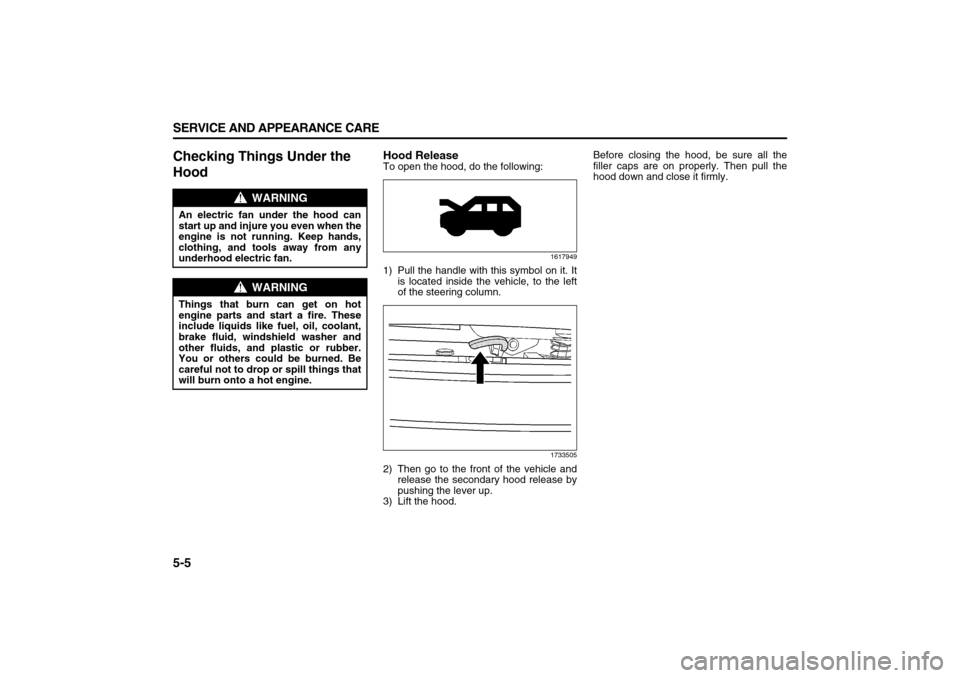
5-5 SERVICE AND APPEARANCE CARE
78J00-03E
Checking Things Under the
Hood
Hood ReleaseTo open the hood, do the following:
1617949
1) Pull the handle with this symbol on it. It
is located inside the vehicle, to the left
of the steering column.
1733505
2) Then go to the front of the vehicle and
release the secondary hood release by
pushing the lever up.
3) Lift the hood.Before closing the hood, be sure all the
filler caps are on properly. Then pull the
hood down and close it firmly.
WARNING
An electric fan under the hood can
start up and injure you even when the
engine is not running. Keep hands,
clothing, and tools away from any
underhood electric fan.
WARNING
Things that burn can get on hot
engine parts and start a fire. These
include liquids like fuel, oil, coolant,
brake fluid, windshield washer and
other fluids, and plastic or rubber.
You or others could be burned. Be
careful not to drop or spill things that
will burn onto a hot engine.
Page 190 of 274
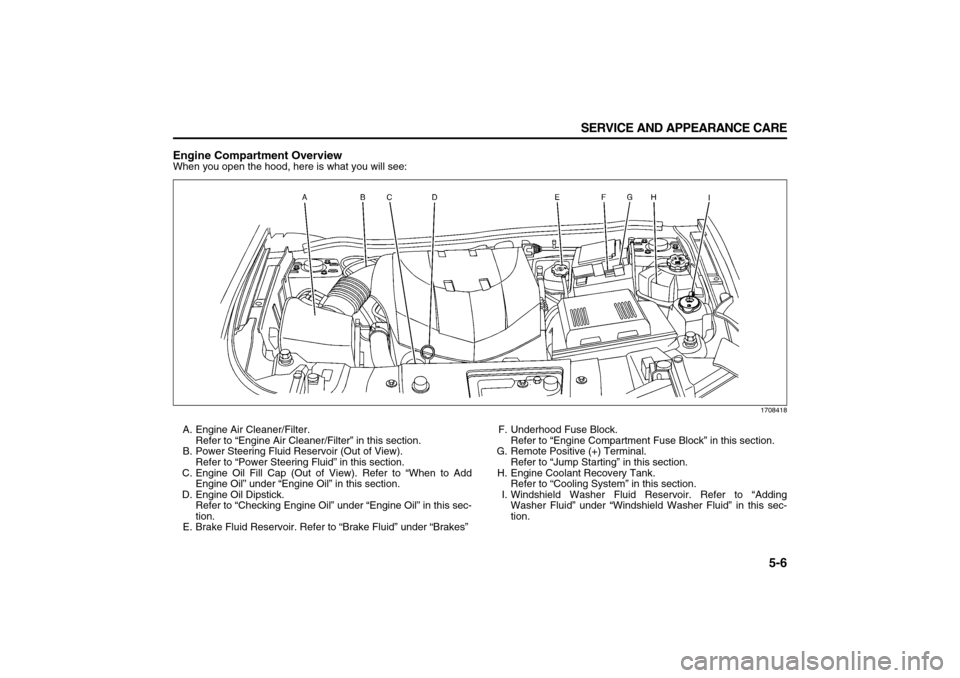
5-6 SERVICE AND APPEARANCE CARE
78J00-03E
Engine Compartment OverviewWhen you open the hood, here is what you will see:
1708418
A. Engine Air Cleaner/Filter.
Refer to “Engine Air Cleaner/Filter” in this section.
B. Power Steering Fluid Reservoir (Out of View).
Refer to “Power Steering Fluid” in this section.
C. Engine Oil Fill Cap (Out of View). Refer to “When to Add
Engine Oil” under “Engine Oil” in this section.
D. Engine Oil Dipstick.
Refer to “Checking Engine Oil” under “Engine Oil” in this sec-
tion.
E. Brake Fluid Reservoir. Refer to “Brake Fluid” under “Brakes”F. Underhood Fuse Block.
Refer to “Engine Compartment Fuse Block” in this section.
G. Remote Positive (+) Terminal.
Refer to “Jump Starting” in this section.
H. Engine Coolant Recovery Tank.
Refer to “Cooling System” in this section.
I. Windshield Washer Fluid Reservoir. Refer to “Adding
Washer Fluid” under “Windshield Washer Fluid” in this sec-
tion.